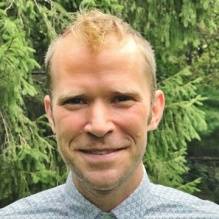
Rebooting computer science education
GSE faculty research informs new computer science teacher preparation program
BY DANIELLE LEGARE

Chris Proctor, GSE assistant professor of learning and instruction
The University at Buffalo’s Graduate School of Education will offer one of the first computer science teacher preparation programs in New York State. Pending approval from the New York State Education Department, the program is expected to enroll its first cohort of students in 2023.
The program seeks to reshape curriculum, perspectives and access relating to K-12 computer science education. Students in the program will gain an in-depth understanding of computer science content knowledge and effective teaching and leadership practices.
“We focus on leadership because, the reality is, if you’re going to become a computer science teacher, you are almost certainly not going into a school that has a big established computer science department,” said Chris Proctor, GSE assistant professor of learning and instruction.
Proctor has led the efforts to develop the program, with the guidance and support of GSE’s Department of Learning and Instruction faculty, including Clinical Associate Professor Elisabeth Etopio, Chair and Associate Professor Erin Kearney and Anne Izydorczak, who is the administrator of UB’s Gifted Math Program.
“It has been exciting to see the new computer science education program take shape, especially through the creative vision and collaborative spirit of Chris Proctor, who is the program’s inaugural director. Computer science education programs are rare in New York, but this one is distinctive and, I believe, will chart new paths for preparation, even in this new area of certification,” said Kearney.
Proctor’s academic and professional background helped inspire the program. After double majoring in English and symbolic systems and then completing a master’s degree in computer science, he went on to teach English and eventually computer science. His time in the classroom crystallized the need to improve inclusion in K-12 education—particularly in computer science.
While teaching in Austin, Texas, he noticed a distinct racial hierarchy in his school. “There was a clear sense of alienation on the part of some Latinx students, and in particular, this extra layer of, ‘are you an illegal immigrant?’ And a lot of these students’ families had been there since long before Texas existed,” said Proctor.
“There’s a long history of U.S. schools erasing people’s languages and suggesting that their language is broken or inadequate … That dynamic is something that I think computer science educators—all educators—ought to be keenly aware of,” he said.
Proctor knew he wanted to conduct research to contribute to the existing body of computational thinking and literacies scholarship. He started using literacy-based strategies from English/Language Arts in his computer science classroom, focusing on communication and reflection, and learning computer science in the context of one’s personal experiences.
He and Yasmin B. Kafai, professor of learning and instruction at the University of Pennsylvania Graduate School of Education, recently published an article in Educational Researcher outlining the framings of computational thinking and literacies. The article, “A Revaluation of Computational Thinking in K–12 Education: Moving Toward Computational Literacies,” illuminates three questions concerning the relationship between computer science and K-12 education:
- Who should learn computer science?
- What should be taught in K-12 computer science?
- How should computer science be taught?
GSE’s new program will equip students to explore these questions while considering how to create a more inclusive computer science education curriculum. Students will study the role computers play in gender, racial, sexual and language identity.
“[The program] prioritizes development of critical approaches, treating the ways we interact with computers as a literacy that has to be thoughtfully cultivated in school environments,” said Kearney. “It is also a program that is invested in the idea that such critical computational literacies, and CS education in general, can contribute to creating healthy and vibrant communities. It’s a computer science education program, but really, it’s all about people and communities.”
Future students will be empowered to think critically about the definition and possibilities of computer science education.
Proctor hopes to recruit students who love computing and aspire to be socially engaged through ethical service work. He also envisions the program leading to local growth: “I would like to see Western New York have a regional identity as a place where really excellent computer teaching is happening,” he said.